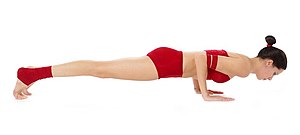Note: This is a project under development. The articles on this wiki are just being initiated and broadly incomplete. You can Help creating new pages.
Chaturanga Dandasana
Chaturanga Dandasana (Sanskrit: चतुरङ्ग दण्डासन; Sanskrit pronunciation: [cɐt̪urɐŋgɐ d̪ɐɳɖɑːsɐn̪ɐ]; IAST: Caturaṅga Daṇḍāsana) or Four-Limbed Staff Pose, also known as Low Plank, is a Yoga asana, in which a straight body parallel to the ground is supported by the toes and palms, with elbows at a right angle.
Etymology
The name comes from the Sanskrit words chatur (Sanskrit: चतुर्; IAST:catur) meaning "four", anga (Sanskrit: अङ्ग; IAST: aṅga) meaning "limb", danda (Sanskrit: दण्ड; IAST:daṇḍa) meaning "staff" (refers to the spine, the central "staff" or support of the body), and asana (Sanskrit: आसन; IAST:Āsana) meaning "posture" or "seat".
Description
In Chaturaṅga Daṇḍāsana the hands and feet are on the floor, supporting the body, which is parallel to and lowered toward, but not touching, the floor. It looks much like a push up, but with the hands quite low (just above the pelvis), and the elbows kept in along the sides of the body.
When performed correctly, it can help prepare the body for arm balance asanas by strengthening important muscles and promoting good form.
In vinyasa styles of yoga, Caturaṅga Daṇḍāsana is part of the Sun Salutations Sūrya Namaskāra A and B. In the sequences it is performed on an exhale, and the dṛṣṭi दृष्टि is the nāsāgre (नासाग्र) with the face pointing forwards. In Sūrya Namaskāra A it is the fourth count (catvāri, चत्वारि), and in Sūrya Namaskāra B it is performed on the fourth, eighth and twelfth counts (catvāri, चत्वारि;aṣṭa,अष्ट;dvādaśa,द्वादश respectively).
In yoga practice without vinyasa the asan is simply held for a period of time (for instance, 30 seconds) with continuous breathing.
